Dinosaurs and other extraordinary prehistoric Pokémon have always been fascinating due to their mysterious nature. People are often amazed with the diverse and unusual appearance since most of them have nothing in common with today's dominant mammals and their scarce look-alikes are not widely known. The most famous prehistoric creatures are dinosaurs which along with other reptile-like creatures like the flying pterosaurs and the aquatic "sea monsters"ichthyosaurs, plesiosaurs and mosasaurs ruled the earth for millions of years while the inferior mammals, which evolved from the monstrous pelycosaurs, lived in their shadows.
The extinct dinosaurs (or at least the ones that didn't evolve to birds) shared their fates with many other remarkable creatures such as various arthropods or cephalopods. Our only source of information about these creatures are their fossilized remains, however a few animals from the ancient eras of life, some of which even predate the dinosaurs and of course man, have managed to survive up to this date. Those are called living fossils and may include animals such as common as a cockroach or a dragonfly.
There's no doubt that Satoshi Tajiri would be inspired by this wide variety of unusual animal forms when creating Pokémon. This shall be the first in a mini-series of articles concerning prehistoric Pokémon among the different generations. We're not going to determine the origin of dragon-like Pokémon such as Charizard or Dragonair but rather analyze only the truth behind Pokémon recognized by the games' plot as fossils.
Prehistoric Pokémon were introduced in the first Generation. Using a process similar to that of the movie film Jurassic Park: scientists of the Cinnabar Island Laboratory were able to extract DNA out of fossils or amber (fossilized resin) and recreate via the process of cloning Omanyte (Helix Fossil), Kabuto (Dome Fossil) and Aerodactyl (Old Amber). Apparently due to their fossilized nature, one of the two types of all prehistoric Pokémon is ROCK.
Omanyte & Omastar


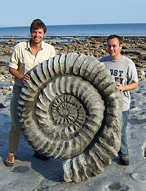
Omanyte (オムナイト/Omunaito)'s name is combination of ammonite an extinct cephalopod, and "omu", the Japanese word for nautilus, a living fossil. Same applies for Omastar (オムスター/Omusutā) which also includes the word "star"probably because it's major tentacles have the shape of a starfish.
The concept of the above Pokémon is centered on the foresaid cephalopod, ammonite. Ammonites have no living close relatives as their order became extinct at the close of the Cretaceous (65 m.y.a.) along with the dinosaurs, however they have a lot in common with another animal in the Cephalopoda class, Nautilus. Their shape resembles a ram horn, and Pilnius the Elder (a roman philosopher, naval and military commander) called their fossils ammonis cornua (horns of Ammon) because of the egyptian godAmmon, god of wind and weilder of the "breath of life”, who was depicted wearing ram's horns. Omanyte's height is 0.4m / 1'04" which is about the average for a Jurassic period ammonite while Omastar is double its size at 1m / 3'03" which is comparable to the Titanites from southern England. Certain specimens of ammonite fossils reach 2 metres (6.5 feet) in diameter.
Pokémon Gold's entry reads: "Apparently, it cracked SHELLDER's shell with its sharp fangs and sucked out the insides."and actually ammonites probably did feed on fishes, crustaceans and small sea creatures. Emerald's entry reads: "An OMASTAR uses its tentacles to capture its prey. It is believed to have become extinct because its shell grew too large, making its movements slow and ponderous."and while most ammonites used to be good swimmers, much like Nautiluses, some ammonoids are though to have been slow-swimming bottom-dwellers, so it is probable that Omastar became extinct due to lack of prey in its hunting area. The extinction of ammonites is hard to be explained and no one has ever found a living fossil up to this date.
Omastar first made an appearance in the animé in episode 46, "Attack Of The Prehistoric Pokémon"along with other prehistoric Pokémon (Omanyte, Kabuto, Kabutops & Aerodactyl).
Did you know that…
The prototype name for Omanyte in the beta version of Pokémon Red and Green was"Ess" while Omastar had the name "Kargo" a concept inspired by "escargot" which is french for snail.
Kabuto & Kabutops
While Omanyte and Omastar are both based on the same animal, Kabuto (カブト/Kabuto) andKabutops (カブトプス/Kabutopusu) have different origins. The name Kabuto derives from Kabuto (兜, 冑) the traditional Japanese helmet as worn by a samurai but also reveals its origin animal since kabutogani (兜蟹) is the Japanese name of the horseshoe crab, another living fossil. Many think that Kabuto is based on a trilobite, however that is not true while it may indeed resemble to some species of the Harpetida order of Trilobites. The Japanese horseshoe crab (Tachypleus tridentatus) is a chelicerate arthropod with a very distinctive shell. Tachypleus tridentatus is the Japanese variant of the most common Limulus polyphemus. They predate dinosaurs by 200 million years and have almost not evolved at all during all these years. They have four compound eyes, and many minor primitive eyes or photo-receptors that react to UV light thus making them a dear subject of researh into the physiology of vision. Kabuto however appears to only have four eyes; two big red ventral eyes (they also appear on the real life horseshoe crab in a lesser form) and two "glowing eyes" on its back according to its Crystal entry. Kabuto measures 0.5m / 1'08" which is the upper bound for a horseshoe crab. According to the animé, oil extracted from a Kabuto is rumored to have interesting medical properties, longevity being one of them. Horseshoe crab's famours blue blood is also extracted commercially for medical purposes such as anti-bacterial tests.

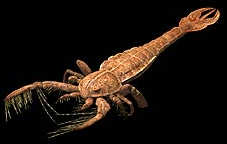
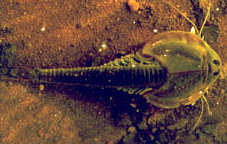
Kabutops on the other hand is losely based on various sea creatures including the horseshoe crab, the triops (tadpole shrimp/shield shrimp), and theeurypterids (sea scorpions). There is an obvious similarity between the shape of its head and the horseshoe crab's shell or the triops . Triops [from the Greek τρι-(tri) meaning three and όψη (opsi) meaning view] have three eyes, and their appearance hasn't changed for the past 220 million years. Apparently, Kabutops is also based on the extinct sea scorpions, a large class of arthropods. The sea scorpions were fearsome and formidable predators 460-445 million years ago, and some (such as Megalograptus) species could grow up to 2 metres or more in lenght. Megalograptus also weilded over-developed spiked claws which probably provided initial inspiration for Kabutops' scythes. Sea scorpions were marine or freshwater predators but they were also alsoable to live on the land for short periods of time and some species are thought to be amphibious. Kabutops could be also classified as an anthropomorphic Pokémon due to its size and its ability to walk on its hind legs.
Did you know that…
Kabuto's name in the beta versions of the first generation games was "Att" while Kabutops' name was "Lantis"; both are derived from the word "Atlantis."
Aerodactyl

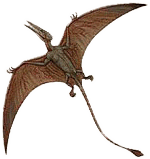
Aerodactyl (プテラ/Ptera) is based on the generic pterodactyl, or otherwise a pterosaur. It's name is derived from aero- [from Greek αέρο- meaning of air] and dactyl [from Greek δάκτυλο meaning finger]. While some may claim that it is based on Pterodactylus, evidence such as the long tail or the backbone over the shoulders show that is more closely related to species of the Rhamphorhynchoidea.
While pterosaurs dominated the skies for millions of years due to the absence of birds, recent studies have proved that it was some dinosaur species that evolved into birds, and not the pterosaurs. Pterosaurs because extinct by the great extinction that wiped out dinosaurs and many other animals at the end of the Cretaceous period. Their wings were formed by membranes of skin attached to the extremely long fourth finger of each arm and extending along the sides of the body. Aerodactyl could be a medium size pterosaur since its size of 1.8m / 5'11" and estimated wingspan of 4 metres, is nothing to be compared with Quetzalcoatlus' 12 metre wingspan; surprisingly Aerodactyl weighs 59.0kg, 10kg more than the average Quetzalcoatlus!
Did you know that…
Aerodactyl is one of the fastest Pokémon beside the fact that it is of ROCK type.
Perhaps some of you might be wondering why so many creatures have not survived to our days; its something I neglected to mention in the first article of the series. There are certain events in Earth's life that are called Mass Extinctions. These are marked by major catastrophs caused by volcanic activity, asteroid impacts, variations of global temperature etc. There have been at least five major Extinction events that repeatedly wiped out up to 96% of earth's species and eventually cleared the way for mammals' domination.While the second Generation had no fossils at all, the third "advanced" Generation packs three very interesting Pokémon based on some extremely old creatures. They could be brought back to life from Devon Corp.'s laboratories in Rustboro City using DNA samples from a Claw Fossil (Anorith) or a Root Fossil (Lileep).Relicanth
Relicanth (ジーランス/Jīransu) unlike other fossil Pokémon, is not revived from a fossil but it can be found in the wild instead. However it is still considered a fossil Pokémon due to its type (Water/Rock) and its origin. Relicanth's name comes from relic and coelacanth. Coelacanth ['hollow spine' from Greek κοίλος (coelos) meaning hollow and άκανθος (acanthos) meaning thorn/fishbone] is the name for an order of ancient fish which were thought to be extinct (due to lack of fossil records) until recently, they're therefore living fossils. A weird fact about their name is that κοίλος (coelos) is pronounced "kilos" therefore coelacanth's pronounciation "see-lah-kanth" is wrong. They appeared 370 million years and have barely changed since then.There are two species of coelacanth: Latimeria chalumnae which has a deep blue colour and lived in the west Indian Ocean and the brown-tinted Latimeria menadoensis which lives in Indonesia. They are lobe-finned fish and their fins are supported by small bone structures which led many scientists in the past to belive that they were the missing links between marine and land animals which is false since coelacanth is the sole survivor of a line of extinct animals. They also have bone like scales (which explains why Relicanth is described to have tough scales that are like craggy rocks) and a special electrical field sensor called a rostral organ which they use to detect their prey especially in low-light conditions. Coelacanths usually live in great depths (as deep as 700m/2296.5ft) since their eyes are very sensitive to light are are very rarely caught by fishermen and that's one of the reasons they were thought to be extinct. It seems that local fishermen would throw them back in the water if caught by accident because they are inedible as their bodies are rich in a laxative oil. They can grow up to 2m/6.5ft and their average weight is 80kg/176 pounds. Female coelacanths keep their eggs inside them and thefore give birth to live young, in clutches numbering between five and twenty-six!Did you know that…
There is also a Digimon called Coelamon that is based on Coelacanth.Anorith & Armaldo
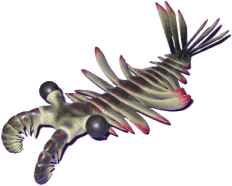

 Anorith (アノプス/Anopusu) is considered to be a kind of Pokémon predecessor, which is pretty logical considering it is based on Anomalocaris, an extinct carnivorous marine animal that lived in the Cambrian period, 530 million years ago. It is probable that the -ith in its name comes from the Greek word λίθος (lithos) meaning stone. TheAnomalocarids were agile predators of a remarkable size that few other Cambrian animals could match; some specimens grew up to 2 metres. Anorith would be a medium size Anomalocarid with a lenght of 0.7m / 2'04".The photo of an Anomalocaris model that appears on the right was found on a japanese website about prehistoric animals and is the only one that has a matching colour scheme with Anorith; it seems probable that Satoshi Tajiri and Ken Sugimori were inspired by this very model.Their appearence and the way the moved would be unfamiliar to us since they have no similarities to any living creature. In front of their mouth they had two shrimp-like appendages which have apparently been replaced by "extendable" claws in Anorith's case. Their flat, segmented body was equipped with a series of swimming loves. Anomalocaris would undulate these flaps and therefore simulate a wave-like motion, probably similar to the way rays do.Anomalocaris were often missidentified by paleontologists. The name Anomalocaris (unusual shrimp) itself originally referred to the detached arms or a fossilized specimen; it's mouth was mistaken for a jellyfish and its body was thought to be a sponge.Armaldo (アーマルド/Āmarudo) on the other hand is freely based on Anomalocaris with apparently, an inheritance of elements by dinosaurs like theStegosaurus or Ankylosaurus however its name comes from armor or possibly armadillo. It has a hight of 1.5m / 4'11" which is essentialy the same with the player's height in the videogames. It's supposed to live on land and walk on its hind legs and is probably one the first Pokémon that chose leave the sea behind. It is protected by an extremely tough shell and is armoured with two "enormous" extendable claws that "have the power to punch right through a steel slab".
Anorith (アノプス/Anopusu) is considered to be a kind of Pokémon predecessor, which is pretty logical considering it is based on Anomalocaris, an extinct carnivorous marine animal that lived in the Cambrian period, 530 million years ago. It is probable that the -ith in its name comes from the Greek word λίθος (lithos) meaning stone. TheAnomalocarids were agile predators of a remarkable size that few other Cambrian animals could match; some specimens grew up to 2 metres. Anorith would be a medium size Anomalocarid with a lenght of 0.7m / 2'04".The photo of an Anomalocaris model that appears on the right was found on a japanese website about prehistoric animals and is the only one that has a matching colour scheme with Anorith; it seems probable that Satoshi Tajiri and Ken Sugimori were inspired by this very model.Their appearence and the way the moved would be unfamiliar to us since they have no similarities to any living creature. In front of their mouth they had two shrimp-like appendages which have apparently been replaced by "extendable" claws in Anorith's case. Their flat, segmented body was equipped with a series of swimming loves. Anomalocaris would undulate these flaps and therefore simulate a wave-like motion, probably similar to the way rays do.Anomalocaris were often missidentified by paleontologists. The name Anomalocaris (unusual shrimp) itself originally referred to the detached arms or a fossilized specimen; it's mouth was mistaken for a jellyfish and its body was thought to be a sponge.Armaldo (アーマルド/Āmarudo) on the other hand is freely based on Anomalocaris with apparently, an inheritance of elements by dinosaurs like theStegosaurus or Ankylosaurus however its name comes from armor or possibly armadillo. It has a hight of 1.5m / 4'11" which is essentialy the same with the player's height in the videogames. It's supposed to live on land and walk on its hind legs and is probably one the first Pokémon that chose leave the sea behind. It is protected by an extremely tough shell and is armoured with two "enormous" extendable claws that "have the power to punch right through a steel slab".Did you know that…
There is also a Digimon called Scorpiomon (Japanese: Anomalocarimon) that is based on Anomalocaris.Lileep & Cradily
Lileep (リリーラ/Rirīra) is based on another family of ancient marine animals, called crinoidswhich are also called "sea lilies" since they are often mistaken for plants. Its name originates from lily and peep because it looks like it's peeping out of its stem. Crinoids date back to the Ordovician period (~450 million years ago) however very few species have survived into our days; sea urchins are distant cousins of theirs. They are characterized by a mouth on the top surface that is surrounded by feeding arms and a stem which they use to attach themselves to the seafloor although most modern crinoids are free-swiming and lack that stem. They used to feed on food particles that they collected from the currents flowing past them. Some crinoids were over a meter long which is is close to the size of Lileep and Cradily however didn't look as massive and resembled thick algae.Cradily (ユレイドル/Yureidoru) is also based on crinoids with hints from the Piranha Plants from Super Mario's universe or the Deku Babas from the Legend Of Zelda series. Unfortunately there little to be said about crinoids, since they obviously live a rather boring life.Did you know that…
There are no Digimon based on Crinoids? (That's how boring they are…)
Source: Here




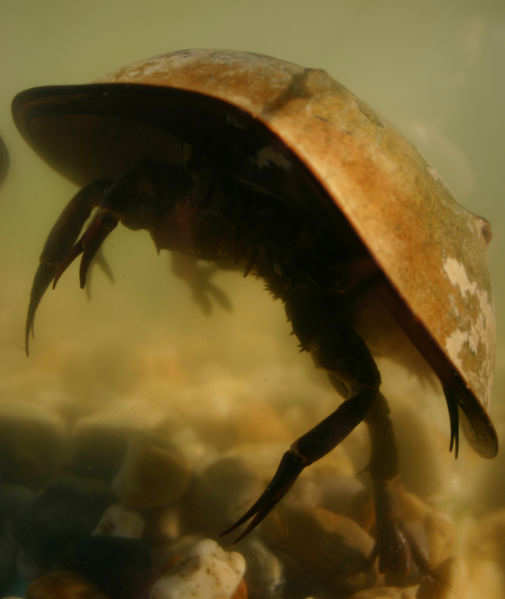
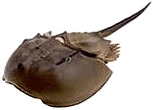
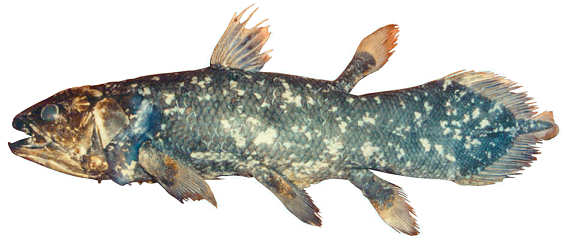

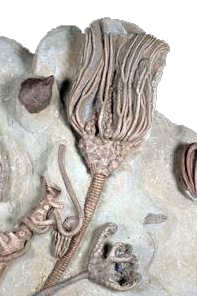
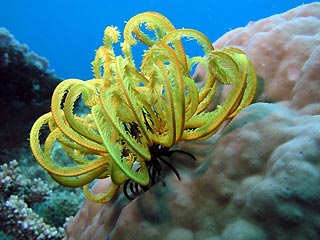


Tidak ada komentar:
Posting Komentar